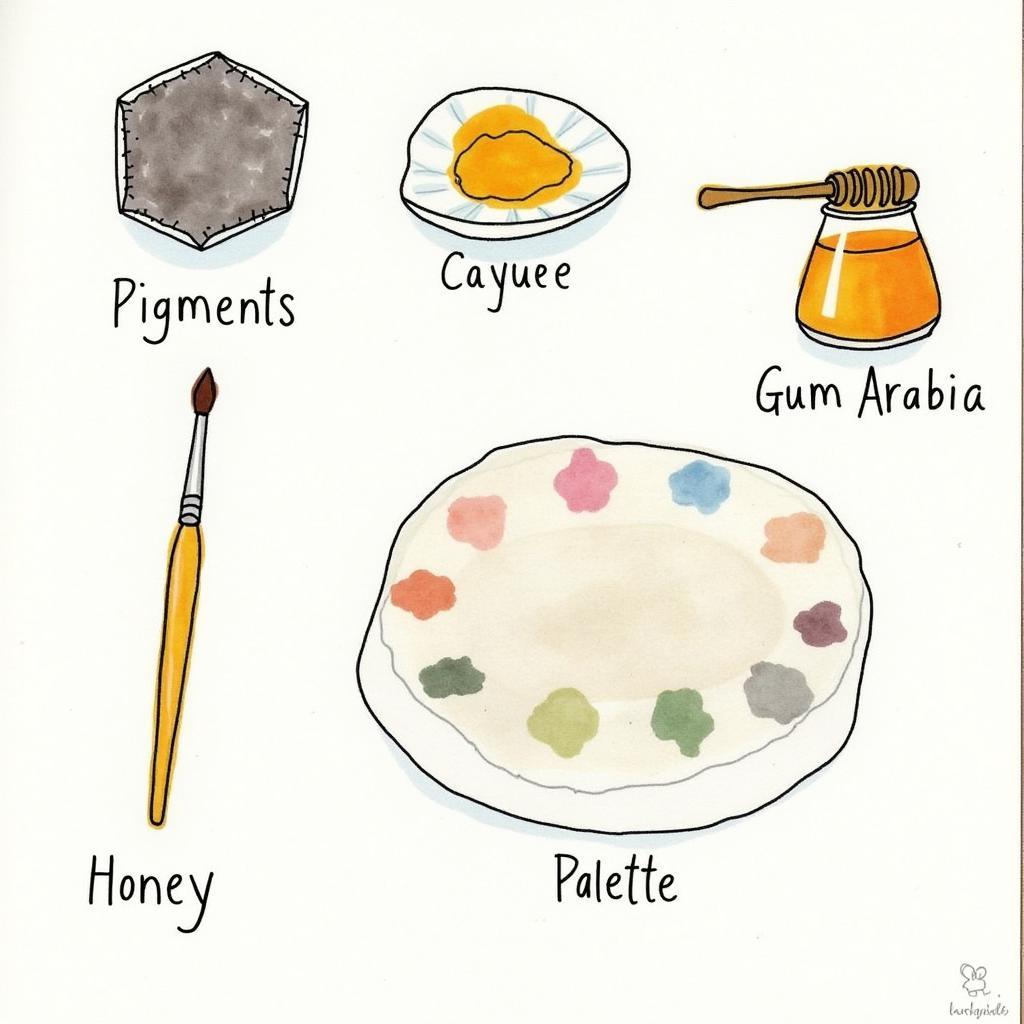Creating your own watercolors is a rewarding experience that allows you to explore a world of vibrant hues and personalized palettes. Whether you’re an aspiring artist, a seasoned painter, or simply curious about the magic behind these paints, this guide will equip you with the knowledge and techniques to make your own watercolors at home. Learn how to transform simple ingredients into beautiful, expressive paints, perfect for capturing your artistic vision.  Homemade Watercolor Supplies
Homemade Watercolor Supplies
Unleashing the Colors: Essential Ingredients for DIY Watercolors
Making watercolors involves combining pigments with a binder that allows them to adhere to paper and be reactivated with water. The key ingredients are:
- Pigment: This is the heart of your watercolor, providing the color. You can use dry pigment powders, which offer the widest range of hues, or explore natural sources like fruits, vegetables, and spices. what fruit can be used to make water colors offers some great insights into this.
- Binder: Gum arabic is the most common binder for watercolors. It’s a natural gum derived from acacia trees that provides the necessary adhesive properties.
- Honey or Glycerin: These act as humectants, keeping your watercolors moist and preventing them from cracking.
- Water: Essential for dissolving the gum arabic and combining the ingredients.
Mixing Your Masterpiece: The Watercolor Making Process
Follow these steps to create your own vibrant watercolors:
- Prepare your workspace: Cover your work surface with newspaper or a protective mat. Have all your ingredients and tools readily available.
- Dissolve the gum arabic: In a small container, mix gum arabic powder with warm water, stirring until it dissolves completely. The consistency should be similar to honey.
- Combine pigment and binder: Gradually add the pigment powder to the gum arabic solution, mixing thoroughly until a smooth paste forms. The ratio of pigment to binder will affect the intensity and transparency of the color.
- Add humectant: Incorporate a small amount of honey or glycerin to prevent the paint from drying out and cracking.
- Mould and dry: Pour the watercolor mixture into small pans or wells of a palette. Allow the paint to dry completely, which may take several days.
Exploring Color Variations and Techniques
Once you’ve mastered the basic process of how to make water colors, you can experiment with different pigments and techniques to achieve unique effects.
- Layering: Applying multiple layers of watercolor can create depth and richness. Start with lighter washes and gradually build up to darker tones.
- Blending: Watercolors are renowned for their blending capabilities. Experiment with blending different colors on the paper to create smooth transitions.
- Creating textures: Use a dry brush technique or add salt to wet washes to create interesting textures.
“Experimentation is key when creating your own watercolors,” advises renowned color specialist, Amelia Dubois. “Don’t be afraid to try different pigment combinations and explore various techniques to discover your own unique style.”
From Kitchen to Canvas: Natural Pigments from Food
do food colors expire is an important question to consider if you’re venturing into natural pigments. You can extract vibrant colors from various foods, including berries, beets, spinach, and turmeric. Simply simmer the chosen food in water, strain the liquid, and then mix it with the gum arabic binder and humectant. Remember that natural pigments may not be as lightfast as commercial pigments.
how to make skin tone color with watercolor offers a practical example of blending specific hues to achieve a desired result. This same principle can be applied when working with your homemade watercolors.
Conclusion: Embrace the Joy of Homemade Watercolors
Making your own watercolors is a fulfilling journey that allows you to connect with the very essence of color. By understanding the basic principles of how to make water colors, you can unlock a world of creative possibilities. Whether you’re an experienced artist or just starting out, the joy of creating and using your own handcrafted paints is truly unmatched.
FAQs
- How long do homemade watercolors last? Properly stored, homemade watercolors can last for several months. Keep them in airtight containers in a cool, dry place.
- Can I use other binders besides gum arabic? While gum arabic is the most common binder, you can experiment with other options like egg yolk or acacia honey.
- Where can I find pigment powders? Pigment powders can be purchased online or at art supply stores.
- What if my watercolors are too thick? Add a drop or two of water to thin the consistency.
- How can I make metallic watercolors? Incorporate mica powders into your watercolor mixture to create shimmering metallic effects.
- Are homemade watercolors safe for children? Use non-toxic pigments and supervise children closely when they are working with watercolors.
- Can I use these watercolors on fabric? While primarily intended for paper, you can experiment with using them on fabric, but the results may vary.
If you need further assistance, please contact us at Phone Number: 0373298888, Email: [email protected] or visit our address: 86 Cầu Giấy, Hà Nội. We have a 24/7 customer service team.